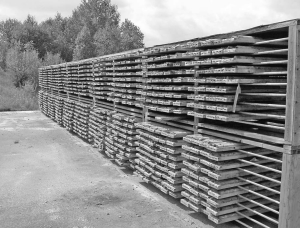New resource estimates for two of its deposits in the Kirkland Lake camp have brought Queenston Mining’s (QMI-T) gold resources in this corner of northeastern Ontario to 640,000 measured and indicated oz. and 577,000 inferred oz.
An initial resource estimate for the McBean deposit in Kirkland Lake’s Gauthier Township was based on a 118-hole, 50,500-metre drill program on four primary lenses that began in 2008. Six hundred metres west of McBean, an updated resource estimate was completed on nine lenses of the Anoki deposit.
Both deposits are open at depth, along strike, and are being explored by surface drilling. The McBean and Anoki resources are key components in Queenston’s strategy of advancing four 100%-owned gold deposits in the Kirkland Lake camp towards production supported by a central mill.
“The combined McBean and Anoki deposits provide a significant shallow resource base of 217,000 measured and indicated ounces and 237,000 inferred ounces that is already developed by a ramp, underground levels and an open pit,” Charles Page, Queenston’s president and chief executive, explained in a statement.
The McBean deposit, at a cutoff grade of 2.5 grams gold per tonne, has capped measured and indicated resources of 706,000 tonnes grading 4.64 grams gold for 105,700 contained ounces gold. In the inferred category, McBean contains capped resources of 1.22 million tonnes grading 4.71 grams gold for 184,700 oz. gold.
Measured and indicated resources at the same cutoff grade at Anoki amount to 730,000 tonnes grading 4.74 grams gold for 110,700 oz., while inferred resources total 337,000 tonnes grading 4.8 grams gold for 52,100 oz. gold.
If the capped resources in the two deposits are combined, the total reaches 1.44 million tonnes grading 4.69 grams gold for 216,400 oz. gold in the measured and indicated category and 1.56 million tonnes grading 4.73 grams gold for 236,800 oz. in the inferred.
Grade capping at McBean varied from 15 grams gold to 60 grams gold per tonne in its four resource domains, while it ranged from 6 grams gold to 50 grams gold in nine resource domains at Anoki.
The McBean deposit was discovered in 1928, and from 1930 to 1951 was developed and explored by three shafts and five underground levels to a depth of 220 metres from surface.
During the mid-1980s, the upper portion of the McBean deposit was mined from an open pit by a joint venture between Queenston and Inco, and the ore was processed at the refurbished Upper Canada mill. Production added up to about 50,000 oz. of gold from 506,000 tonnes grading 3 grams gold per tonne with mill recoveries from a cyanide leach circuit of 95%.
Production ground to a halt when gold prices dropped below US$400 per oz., and Queenston later bought Inco out in 1996.
The resources at McBean are primarily contained in four lenses that dip 70 to the south and plunge east. The lenses are within the deformation corridor of the Larder Lake Break hosted by altered ultramafic rocks including green carbonate and altered tuff and cut by a series of felsic intrusives.
Drilling has traced the zones over a length of 700 metres and to a depth of 700 metres that remain open to the east, west and at depth. An exploration drill is now targeting the downdip/plunge potential below 600 metres.
The Anoki deposit was discovered in 1916 and from 1938-40 was developed by a shaft and four levels to a depth of 230 metres from surface. In 1987, Queenston and joint-venture partner Inco completed underground exploration from a ramp driven to a depth of 236 metres and along four levels.
In 1988, a 33,340-tonne bulk sample from Anoki was processed at the Upper Canada mill averaging 3.3 grams gold per tonne and producing about 3,500 oz. gold. The mill achieved 95% recoveries and the joint venture completed a feasibility study in 1990. Due to low gold prices, however, the project was put on hold and in 1996, Queenston purchased Inco’s interest in the deposit.
The resources at Anoki occur in nine lenses that are within a 50-to 100-metre-thick package of altered basaltic flows in the hangingwall, south and adjacent to the Larder Lake Break, about 600 metres west of the McBean deposit.
The lenses are vertical dipping and east plunging. The mineralization has been identified over a length of 400 metres and to a depth of 430 metres from surface, where it remains open at depth and to the east. One drill is testing the gap between the Anoki and McBean deposits both along plunge and to depth and will also target the potential for new lenses of mineralization below 500 metres.
In addition to the McBean and Anoki deposits, Queenston owns 100% of the Upper Beaver and Upper Canada deposits. It is also exploring the new South Mine complex with joint-venture partner Kirkland Lake Gold(KGI-T) on the South Claims property and on its 100%-owned AK property.
The Toronto-based company has working capital of $40 million and a 2010 exploration budget of $15 million.
At presstime, the company traded at $5.26 per share in a 12- month window of $2.40-6.70. Queenston has 60.1 million shares outstanding.


Be the first to comment on "Queenston Banking On Kirkland Lake To Return To Producer Status"